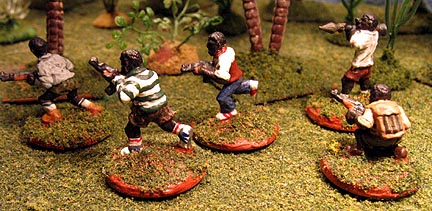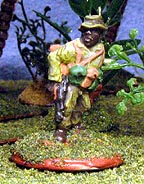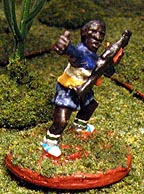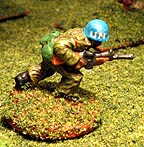

Welcome to the pages dealing with my latest gaming project -- Skirmish wargaming in 20th Century Africa. As I mention on the Gunpowder page, I've created a set of rules (with help from my friends) that combines the combat system of Heroscape with the organizational system of AK-47. The best description of the genesis of this project is in a series of articles I wrote for the HMGS Great Lakes newsletter (which I edit), The Herald. Here are links to those articles:
One of the fun things about this project -- and one of the most interesting things about this period of history -- is the bewildering array of factions that fought for control of The Congo and its rescources. There were government forces, militia, separatist rebels of several different types, Belgian Army forces reasserting colonial control (or not),UN Forces intervening, white mercenaries, neighboring African nations meddling, religiously inspired movements -- you name it. The Congo probably saw it in its turbulent first years of independence from Belgium.
Here are some pictures of the troops I've painted for this period.
 Armee National Congolaise
(ANC)
Armee National Congolaise
(ANC)Originally called the "Force Publique" by its Belgian colonial creators, the National Army of Congo staged a mutiny shortly after independence. It objected to the presence of Belgian officers and NCOs remaining in its ranks, and of course, to its paltry pay in such a potentially rich country. In response, Congo's leaders reorganized the army as the ANC, removing the white officers, and essentially caving in to the army's demands.
As such, the ANC is a mixed bag -- some units (under good officers) are likely effective and have decent equipment, while others the opposite is true. When painting these guys, I figured that uniform replacement was anything but regular, so there is a mix of new and old clothing, military and civilian. The dominant theme is olive drab -- which was likely in abundance as U.S. Army surplus after the Korean conflict.
 White
Mercenaries
White
MercenariesMercenaries were hired by various sides -- most of them white Europeans from France, Britain or Belgium -- to either bolster the forces of a breakaway province (like Katanga), or to provide supposedly steady, professional troops for a government. Neighboring Rhodesia formed a conduit for organization and equiping newly-recruited bands of "Dogs of War." Those recruiting mercenaries ostensibly CHECKED into the BACKGROUND of the soldiers to ensure they hired on only those who'd actually seen combat, but as could be expected, mercenary performance was a mixed bag. Like with the French Foreign Legion, recruits were apt to embellish their experience to ensure they were chosen.
The Western Press and the United Nations saw the presence of mercenaries in The Congo as particularly abhorrent. UN Forces were actually dispatched to "disarm" mercenary bands known in their area, which often saw mercs taken captive and repatriated to their respective countries. Of course, compared to be ing captured by the enemy -- who'd likely show them little mercy -- there were worse fates. Perhaps the biggest employer of mercenaries was the breakaway province of Katanga. As home to huge mineral riches, the province had the money (or those supporting its breakaway were willing to advance it the money) to hire mercenaries.
 Congolese Militas
Congolese MilitasMany of the troops that fought in The Congo were not uniformed soldiers organized in a unit like the ANC troopers, United Nations contingents, and so on. Many were civilian or tribal militia who went into battle wearing only bits of military equipment or their day-to-day clothes. Most were not as formally trained as the above, and their performance could be expected to suffer. As a matter of fact, some notions reminiscent of the 18th or 19th Century existed in the minds of these soldiers. Some actually believed it was the noise of the rifle that killed the enemy, so took no effort in aiming -- even closing their eyes while shooting. Others -- like the Simba Movement -- thought magical procedures could render them immune to the enemy bullets. "Shades of the Boxer Rebellion at the beginning of the century," you might say.
Anyway, since militia formed a major part of the armies that fought in the wars of The Congo's independence, I certainly had to paint up several batches of these.
 United
Nations Contingents
United
Nations ContingentsContingents from a vast number of countries (most of them African) quickly moved into The Congo when civil unrest broke out following independence. Their performance and reputation varied from country to country, but most citizens were appreciative of their presence and respected them. It was mostly the various rebel or tribal movements whose aims ran at odds with those of the United Nations that had troubles with them. Katanga had a particularly bad experience with them, as The Congo's first prime minister, Patrice Lumumba, was able to browbeat the UN into using them as the spearhead of his invasion of the rebel province. As such, they often came into contact with Katanga's mercenary troops.
In addition, some nations that sent contingents into The Congo were accused of using them to further their own political goals. Ghana, ruled at that time a particularly radical governement in the style of Egypt's Nasser, was said to send instructions directly from their civilian government to the commanders in the field -- bypassing (or circumventing) the authority of the UN commander.
The bright blue helmets of UN Troops make an attractive contrast on the tabletop, and the possibility for intrigue-rich scenarios meant that I had to field a contingent of these troops in my Congo project.